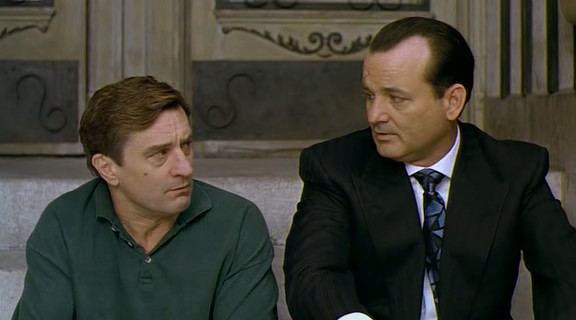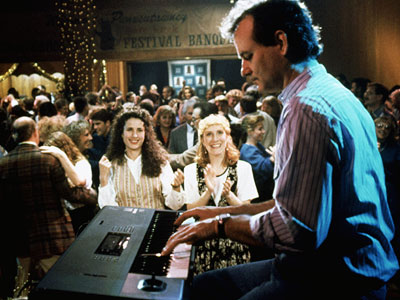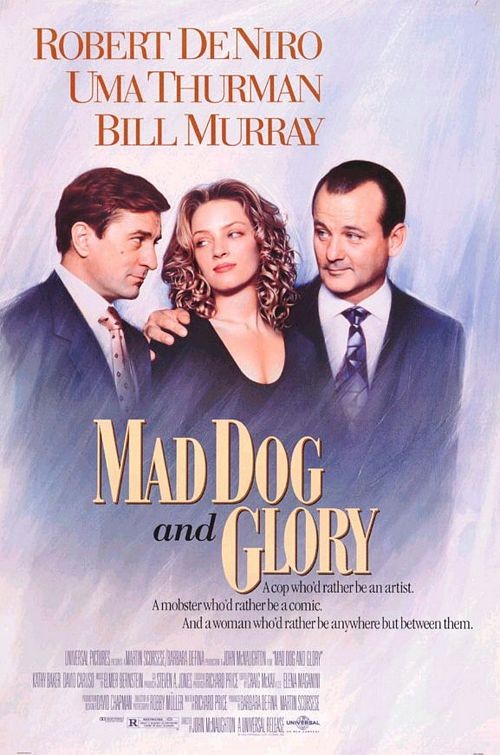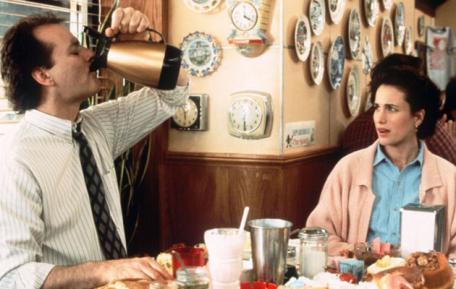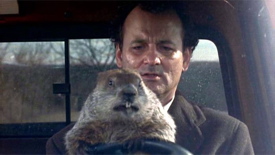From the Chicago Reader (March 5, 1993). –J.R.
MAD DOG AND GLORY
** (Worth seeing)
Directed by John McNaughton
Written by Richard Price
With Robert De Niro, Bill Murray, Uma Thurman, David Caruso, Mike Starr, Tom Towles, and Kathy Baker.
GROUNDHOG DAY
*** (A must-see)
Directed by Harold Ramis
Written by Danny Rubin and Ramis
With Bill Murray, Andie MacDowell, Chris Elliott, Stephen Tobolowsky, Brian Doyle-Murray, and Marita Geraghty.
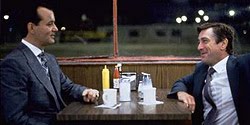
As far as the mainstream is concerned, Martin Scorsese and Robert De Niro are beacons of artistic integrity and originality, while Harold Ramis and Bill Murray are at best unpretentious entertainers; screenwriter Richard Price (The Color of Money, Sea of Love) is a respected pro, and director John McNaughton (Henry: Portrait of a Serial Killer, The Borrower) is a promising maverick. But all of these assumptions are challenged in one way or another by the two latest Bill Murray movies. In Price and McNaughton’s Mad Dog and Glory, produced by Scorsese, artistic integrity, originality, craft, daring, and promise seem in shorter supply than in Ramis’s Groundhog Day.
I may be oversimplifying certain issues here. Groundhog Day, which boasts no interesting characters, is held in place by a narrative premise so shopworn — big-city grouch discovers small-town virtues and the error of his ways — that merely thinking about it makes me want to doze off. By contrast, Mad Dog and Glory boasts practically nothing but interesting characters, of which it has quite a few. But from the standpoints of execution and story telling Mad Dog and Glory consists mainly of predictable moves, while Groundhog Day contrives to keep itself pretty fresh throughout.
Trying to account for these discrepancies, I wonder if, considering this country’s puritanical confusions about art and pleasure, Murray in both movies and Ramis and his cowriter Danny Rubin in Groundhog Day are able to function as artists largely because no one expects them to, while McNaughton, Price, De Niro, and Scorsese are all hampered by high expectations. In any case Groundhog Day is a clear commercial success, while Mad Dog and Glory has already been labeled a “problem” film — it was shelved and tinkered with in desperate ways (among other things, a new ending was shot after unsuccessful previews) and is finally being released almost as a last resort.
I can’t be counted among Murray’s most loyal fans, but there were indications in Quick Change (1990), which he coproduced, codirected, and starred in — one of his few flops in recent years — that he was getting as bored with his comic persona as I was. The smug and flippant nerd he played in Scrooged seemed to epitomize the tried-and-true character he was trying to shake, a holdover from the Reagan-era celebration of guiltless self-interest in the form of blase sneers. Perhaps the commercial miscalculation of Quick Change, a comedy-thriller about three bank robbers trying unsuccessfully to get out of New York City, was that it deliberately wrote its virtues in lowercase by keeping its characters life-size — a reckless move in a climate where every cinematic gesture is expected to be spelled out in capitals and italics, but it endeared Murray to me for the first time, and it’s still my favorite of his comedies.
Murray got rapped on the knuckles by low box-office returns for impertinently veering away from meat-and-potatoes fare like Meatballs and Ghostbusters — just as he’d been rapped for insisting on cowriting and acting in the 1984 adaptation of W. Somerset Maugham’s The Razor’s Edge. Then he played a superneurotic in What About Bob?, a character almost as self-absorbed as his earlier persona — but less so than his character’s uptight shrink, played by Richard Dreyfuss. In other words, Murray started proving he could modify his persona and even critique some of its more regressive aspects without leaving the audience behind. Groundhog Day and Mad Dog and Glory provide two new chapters in this ongoing autocritique.
In Mad Dog and Glory, Murray plays not the hero but a charismatic, albeit wacko, gangster and loan shark named Frank who befriends the hero, a shy and solitary police photographer named Wayne (Robert De Niro), ironically nicknamed “Mad Dog” by his colleagues. Frank meets Wayne when Wayne inadvertently saves his life during a convenience-store holdup, even though Wayne behaves like a coward during the incident while Frank spits defiantly in the thief’s face. Inviting Wayne to his nightclub (cutely known as the Comic-Caze — as in kamikaze –Club), where he occasionally works as a mediocre stand-up comic, Frank decides to show his gratitude with a “gift” — one of his barmaids, Glory (Uma Thurman), who’s paying off a debt of her brother’s and so is “owned” by Frank.

We quickly discover that Frank’s “generosity” is strictly of the controlling kind, and Wayne finds himself obliged to go through the motions of keeping Glory for a week to satisfy Frank. Naturally — and here’s where the movie kicks into the tired routine from which it never fully recovers — Wayne falls in love with Glory and wants to keep her, or at least to remove her from Frank’s clutches, for more than a week. It’s an idea that might have been halfway palatable if the filmmakers had somehow contrived to make Glory a real flesh-and-blood character and not just an object of exchange, but they didn’t. It doesn’t appear to be Thurman’s fault; it seems more a limitation of the script. Significantly, a sound-bite refrain, always made in reference to Wayne, is “No guts, no glory.” This has an obvious punning relation to the heroine’s name and the movie’s title, but it’s symptomatic of the movie’s limitations that the heroine’s function as a human beanbag exceeds her reality — she’s roughly five parts glory to one part Glory.
It’s a problem shared to some degree by Scorsese, Price, and McNaughton’s other works, where male prerogatives, even at their most deranged, periodically overwhelm — to the point of defining — female identities. (In “Life Lessons,” the Scorsese sketch scripted by Price for New York Stories, the woman is supposed to be as important as the man, yet she’s defined exclusively in relation to his ego — which is precisely what the story is about.) It may help to explain why Mad Dog and Glory was furnished with a new ending after test marketing — an ending that’s neither satisfying nor convincing, though the original script probably wouldn’t have worked either.
Recutting comedies on the basis of audience responses at previews may have some logic, but I seriously doubt that movies have ever been improved artistically by this process — a distinction that seems worth making precisely because of the reputations of Scorsese and company as artists. (Improving business is, of course, another matter. It makes perfect box-office sense that Glenn Close’s character in Fatal Attraction should be brought back from the dead and then blown away by the hero’s wife rather than be allowed to commit suicide — a direct result of test marketing. The disappointing finale of Army of Darkness is reportedly also a result of test marketing.)
In Mad Dog and Glory — readers who don’t like to have endings disclosed should skip the rest of this paragraph — both the original and current versions climax in a street fight over Glory between Wayne and Frank that Wayne loses, though Frank winds up relinquishing all claims to her, and she willingly returns to Wayne. In the original Glory views the fight from a distance; later she turns up at Wayne’s flat, where he’s desolately singing and dancing along with a record of Louis Prima’s rendition of “Just a Gigolo.” In the release version she’s at the fight, has a voice in the proceedings, and at the end says to Wayne, “Let’s go home.” What seems more honest (if more offensive) in the original is that the crucial event is clearly between the two men. In the current ending the offense may be lessened by granting Glory a voice, but because she was never established as much of a character it’s the voice of an automaton. In spite of Thurman’s charm, the effect seems forced and awkward.
Before Murray was cast in this movie De Niro was offered a choice between the two male leads; he chose Wayne, perhaps to try his hand at a less obvious part for him. It’s a good thing he did, even if his Wayne winds up a bit too conventionally and blandly lovable, because De Niro playing Frank sounds like a performance we already know, while Murray keeps us alert and guessing. (Some of Murray’s better riffs come from references to his offscreen female therapist — the only woman he seems associated with apart from Glory — such as “My therapist says I crave recognition more than actual achievement,” which suggests a calmer if more lethal version of the neurotic in What About Bob?) Some of the same liveliness can be found in David Caruso as Wayne’s fearless police partner, Mike Starr as Frank’s celebrity-spotting bodyguard and stooge, and McNaughton regular Tom Towles in a smaller part. Less fortunate is Kathy Baker, who’s assigned the role of Wayne’s next-door neighbor; she’s a talented actress, but apparently because she’s a woman she’s obliged to play a plot function rather than a person.
No such distinctions can be made about Groundhog Day because virtually all of the characters are equally unfresh and uninteresting. What keeps it entertaining, apart from a few brief slapstick interludes, is the unorthodox narrative construction — and stock characters may serve this cause better than interesting characters would because they distract less from the narrative mechanisms.
Murray’s hero in Groundhog Day is a TV weatherman from Pittsburgh, a self-centered grouch named Phil who makes an annual trip to Punxsutawney, Pennsylvania (shot in Woodstock, Illinois), to cover the Groundhog Day festival with his producer (Andie MacDowell) and cameraman (Chris Elliott). Arriving in town the night before the holiday, he checks into a boardinghouse, meeting his coworkers in the city park the next morning. Once their work is done, they discover that the highway is closed because of heavy snowfall and that they must stay in town for another night. When Phil wakes up in the boardinghouse the next morning, this “next” morning turns out to be exactly the same as the previous one. And for most of the remainder of the movie he seems condemned to an endless replay of the same day and string of daily events, one February 2 after another.
It isn’t a precise replay, however: everyone else’s initial behavior may be exactly the same, but Phil is free to change his behavior, and the fact that he does sets in motion most of the remaining action in the film. This creates a certain philosophical ambiguity about what “the same day” means or consists of, since the movie’s solipsistic definition implies a series of makeshift parallel universes that exist solely to provide Phil with a perpetual testing ground. On the one hand, Phil seems stuck eternally in a trap — unable to escape February 2 in more or less the same way that Murray’s bank-robber hero in Quick Change was unable to escape New York City; on the other hand, everyone else seems trapped in the same lines and gestures and situations, at least until Phil alters his own behavior.
Thanks to this distinction, most of the movie consists of Phil’s self-education, self-improvement, and self-gratification via trial and error. On one February 2 he’ll ask a woman in a coffee shop for information about herself so that on the next February 2 he’ll be able to use this information to seduce her; after he’s honed this technique he applies it to wooing his producer. On one February 2 he’ll bribe a piano teacher to send away her present student and teach him the rudiments of playing; on the next February 2 he’ll return to the same teacher with the same offer and after a long series of such lessons he’ll become a proficient musician.
Though the movie doesn’t bother to make firm distinctions between Phil’s self-improvement and self-gratification, it generally implies a moral awakening of some sort as Phil gradually becomes more attuned to the needs and desires of others as well as to the virtues of small-town living; in other words, becoming all-knowing and omnipotent like God actually turns him into a nicer guy. Fortunately, the movie spares us any lectures on this point — which becomes more dubious the longer we’re compelled to think about it — and instead merely demonstrates it to us over numerous February 2s, effectively turning it into a formal postulate more than a thematic one. (As a thematic premise, the idea may carry somewhat more weight and conviction if one relates it to the experience of filmmakers — or TV broadcasters like Phil and his small team, for that matter — shooting take after take until they finally “get it right.” The plot of Groundhog Day as a whole can be summarized as the process Phil undergoes in the course of “getting” February 2 — his February 2 — “right.”)
What ultimately makes this fantasy of infantile gratification more charming than obnoxious is the adeptness of screenwriters Danny Rubin and Harold Ramis as well as Ramis’s light directorial touch in making the developments pleasurable in a musical way rather than a series of rigid variations on a theme. (Reduced to its status as a message-filled parable, the movie is little more than a replay of A Christmas Carol with It’s a Wonderful Life trimmings.) In short, without wearing any of its art on its sleeve, Groundhog Day gracefully organizes the highly formalized theme and variations somewhat in the manner of an Alain Resnais film like Last Year at Marienbad, Je t’aime, je t’aime, or Providence.
Murray’s nonchalant acting style has a lot to do with this feat, because he seems to be coasting rather than working. The fact that he’s also critiquing his usual persona may be incidental in the long run, because he’s replacing that persona with another form of hotshot who isn’t much better. (Both hotshots seem equally obsessed with scoring, for instance, and the substitution of political correctness for political incorrectness seems to leave this preoccupation unchanged.) But the fleetness and phrasing of the performance matter more than what it happens to be saying.
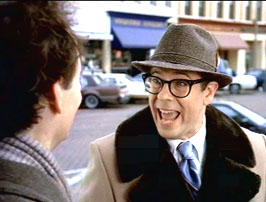
Published on 09 Sep 2011 in Featured Texts, Featured Texts, by jrosenbaum

